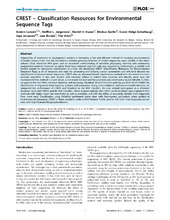| dc.description.abstract | Sequencing of taxonomic or phylogenetic markers is becoming a fast and efficient method for studying environmental microbial communities. This has resulted in a steadily growing collection of marker sequences, most notably of the small-subunit (SSU) ribosomal RNA gene, and an increased understanding of microbial phylogeny, diversity and community composition patterns. However, to utilize these large datasets together with new sequencing technologies, a reliable and flexible system for taxonomic classification is critical. We developed CREST (Classification Resources for Environmental Sequence Tags), a set of resources and tools for generating and utilizing custom taxonomies and reference datasets for classification of environmental sequences. CREST uses an alignment-based classification method with the lowest common ancestor algorithm. It also uses explicit rank similarity criteria to reduce false positives and identify novel taxa. We implemented this method in a web server, a command line tool and the graphical user interfaced program MEGAN. Further, we provide the SSU rRNA reference database and taxonomy SilvaMod, derived from the publicly available SILVA SSURef, for classification of sequences from bacteria, archaea and eukaryotes. Using cross-validation and environmental datasets, we compared the performance of CREST and SilvaMod to the RDP Classifier. We also utilized Greengenes as a reference database, both with CREST and the RDP Classifier. These analyses indicate that CREST performs better than alignment-free methods with higher recall rate (sensitivity) as well as precision, and with the ability to accurately identify most sequences from novel taxa. Classification using SilvaMod performed better than with Greengenes, particularly when applied to environmental sequences. CREST is freely available under a GNU General Public License (v3) from http://apps.cbu.uib.no/crest and http://lcaclassifier.googlecode.com. | en_US |

